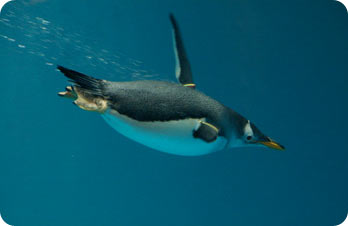On a solid surface, a penguin looks anything but graceful. Once it slides, dives, or flops into the water, though, it’s a completely different story -- the penguin soars through the water as gracefully as any of its kin soar through the air. In fact, you might say that the penguin is “flying” through the water.
 Gentoo Penguin swimming underwater at Nagasaki Penguin Aquarium, Nagasaki, Japan. Credit: Ken Funakoshi.
Gentoo Penguin swimming underwater at Nagasaki Penguin Aquarium, Nagasaki, Japan. Credit: Ken Funakoshi.Penguins get their food exclusively from the sea, so their bodies have evolved to allow them to be efficient hunters in their watery domain. Unlike other birds, for example, their bones are dense and solid, which allows them to sink into the water. And their feathers are shorter, so they don’t trap as much air.
Penguins have stronger wing and breast muscles than most birds, which allows them to generate the extra power they need to fly through water instead of air. As they flap their wings, they change the wings’ angle on the forward and backward strokes so that both push them forward.
Their compact bodies are streamlined, and when they enter the water, they pull their heads in toward their shoulders to reduce drag. And they also pull in their webbed feet, which they use as rudders.
With these adaptations, most penguins move through the water at speeds of about 5 to 10 miles an hour, although some species can go faster. They generally stay underwater for up to about a minute, which allows them to dive a few dozen feet down. But some penguins have stayed under for several minutes and reached depths of hundreds of feet -- graceful birds flying through the ocean depths.

